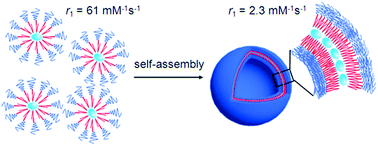A new amphiphilic molecule bearing poly(ethylene oxide) (PEO) and quaternary ammonium group, was designed and synthesized to encapsulate paramagnetic GdIII-containing polyoxometalate (Gd-POM) through electrostatic interaction for obtaining a water-soluble organic–inorganic hybrid building block based on POM. The yielding organic cation-encapsulated Gd-POM (OCEP-Gd) complex exhibited water-solubility and amphiphility, leading to the spontaneous self-assembly into a regular vesicular structure with PEO chains towards water phase and POM units locating at the middle. The vesicular aggregate which has a regular monolayer structure, was further studied by means of dynamic light scattering, transmission electron microscopy, and X-ray diffraction. Due to the synergy of different building units, the self-assembly of the complexes was demonstrated to be efficient to adjust the ability of Gd-POM to accelerate relaxation of water-proton, which results from the paramagnetic property of Gd-POM, to a large extent. The present work provides a new methodology to obtain water-soluble hybrid building blocks based on POM, which may generate more hybrid self-assembly structures in aqueous solution and further direct POM-based materials towards biomedical applications.

You have access to this article
 Please wait while we load your content...
Something went wrong. Try again?
Please wait while we load your content...
Something went wrong. Try again?


 Please wait while we load your content...
Please wait while we load your content...